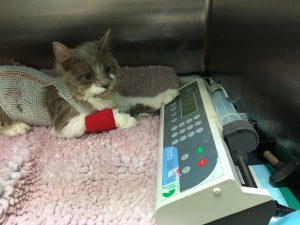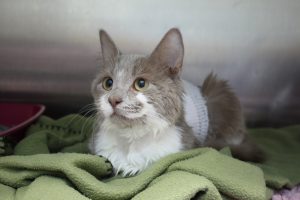Treating sudden onset respiratory distress and suspect chylothorax/ pyothorax
Jasper – a one year old, male, indoor, domestic long hair cat – was referred to our ECC team by his primary care vet for sudden onset respiratory distress and suspect chylothorax/ pyothorax.
On presentation, Jasper was immediately placed in an oxygen cage due to increased respiratory effort and open mouth breathing. Jasper’s body condition score was poor (2/5), indicative of a possible chronic condition. A sample of his pleural effusion was analysed and revealed a large amount of degenerate neutrophils and macrophages, with moderate numbers of intra- and extra-cellular bacteria, confirming a pyothorax.

To treat his condition, Jasper was anaesthetised for the placement of bilateral thoracic drains. Under anaesthesia, Jasper’s condition worsened acutely and he went into cardiopulmonary arrest during the placement of the first chest tube. Cardiopulmonary resuscitation was initiated immediately and consisted of two cycles of continuous chest compressions and ventilation, including multiple medications (dextrose, epinephrine and atropine). Jasper came back to sinus rhythm and remained stable for the rest of anaesthesia, enabling placement of the second chest tube and a thoracic CT scan was performed.

Jasper recovered from anaesthesia very slowly and extubation took place after a few hours. He was temporary blind and ataxic, but regained vision within three days and during this time, his ataxia resolved completely.
Jasper’s pyothorax was treated conservatively with IV antibiotics (amoxicillin/clavulanic acid, metronidazole and enrofloxacin) and chest lavage every 8-12 hours for five days. Analgesia was assessed several times a day so that adjustments could be made to his fentanyl/ ketamine CRI.

